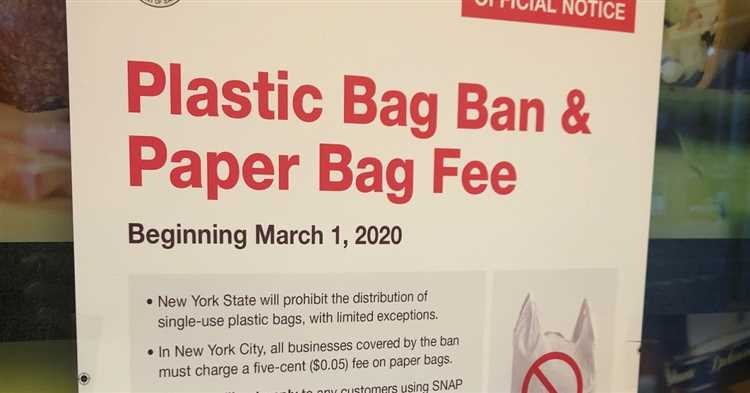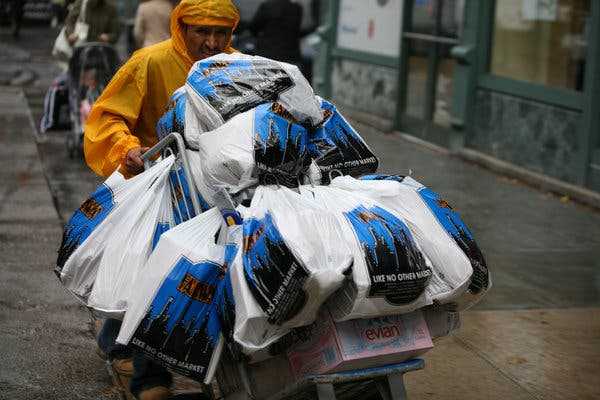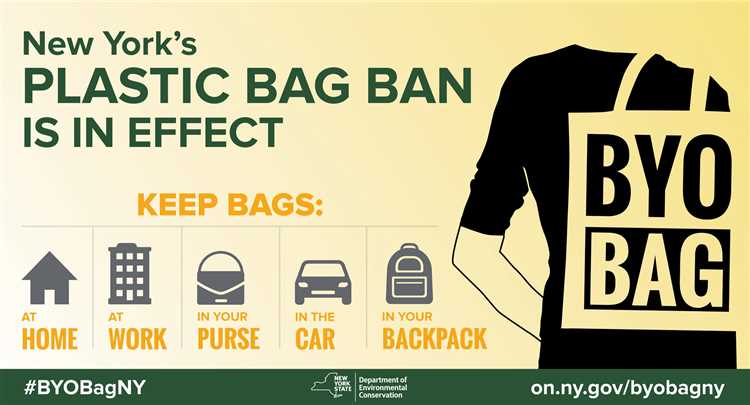
Plastic pollution has become a global environmental crisis, with single-use plastics being a major contributor. As many cities and countries around the world take steps to combat this issue, New York has also been at the forefront of efforts to reduce plastic waste.
In 2020, New York passed a law banning single-use plastic bags in an effort to decrease plastic pollution. The law prohibits most grocery stores, retail shops, and food service establishments from using or distributing single-use plastic bags to customers. This ban aims to encourage the use of reusable bags instead, which can help reduce the amount of plastic waste generated by the city.
However, it is important to note that not all types of single-use plastics are banned in New York. The ban specifically targets plastic bags, but other items such as plastic straws and stirrers are still permitted. Nevertheless, the ban on single-use plastic bags is a significant step towards reducing plastic waste and promoting sustainable practices in the state.
By implementing regulations on single-use plastics, New York hopes to set an example for other regions and inspire similar actions to combat plastic pollution. The ban on plastic bags is just the beginning, as the city continues to explore additional measures to further reduce plastic waste and protect the environment for future generations.
- Overview of Single-Use Plastic Ban in New York
- Background of Single-Use Plastic Ban
- Implications of Single-Use Plastic Ban
- 1. Environmental Benefits
- 2. Transition Challenges
- 3. Economic Implications
- Advantages of Single-Use Plastic Ban
- 1. Environmental Protection
- 2. Conservation of Resources
- Disadvantages of Single-Use Plastic Ban
- Implementation and Enforcement of Single-Use Plastic Ban
- Public Reactions and Future of Single-Use Plastic Ban
- Future Implications
- Question-answer:
- Is single-use plastic banned in New York?
- When did the ban on single-use plastic bags go into effect in New York?
- What are the alternatives to single-use plastic bags in New York?
- Are there any exceptions to the ban on single-use plastic bags in New York?
- What are the penalties for violating the ban on single-use plastic bags in New York?
Overview of Single-Use Plastic Ban in New York
Single-use plastic is currently not banned in New York, but there are efforts underway to reduce its usage in the state. In 2020, the New York State legislature proposed a bill called the Plastic Bag Waste Reduction Act, which aimed to ban single-use plastic bags statewide. However, the bill was not passed.
Despite the lack of a statewide ban, several counties and cities in New York have implemented their own restrictions on single-use plastic. For example, New York City has implemented a ban on plastic bags in most businesses, allowing only reusable bags or paper bags made from 100% recycled materials. Other counties, such as Suffolk County, have implemented similar measures to reduce single-use plastic waste.
Furthermore, there is growing public awareness and support for reducing single-use plastic in New York. Many individuals and organizations are advocating for stronger regulations and policies to address the harmful effects of plastic pollution on the environment and wildlife. The state government has also expressed interest in further tackling the issue of single-use plastic waste.
It is important to note that while single-use plastic bags are a significant contributor to plastic pollution, they are not the only form of single-use plastic. Items such as plastic straws, cutlery, and styrofoam containers also contribute to the overall plastic waste problem. Efforts to reduce single-use plastic in New York should encompass a wider range of items to be truly effective.
In conclusion, while single-use plastic is not currently banned in New York, there are ongoing efforts to reduce its usage through local restrictions and public advocacy. The issue of single-use plastic waste is gaining attention and it is likely that more comprehensive measures will be implemented in the future to address this pressing environmental issue.
Background of Single-Use Plastic Ban
In recent years, there has been a growing concern about the environmental impact of single-use plastics, such as plastic bags, straws, and take-out containers. These items are designed to be used once and then thrown away, leading to significant waste and pollution.
New York, like many other cities and states, has recognized the need to address this issue and has taken steps to ban or limit the use of single-use plastics. The goal is to reduce the amount of plastic waste that ends up in landfills or pollutes our oceans and rivers.
The ban on single-use plastic bags in New York City and the state of New York is an important step in this direction. Single-use plastic bags are one of the most common and visible forms of plastic waste, and they have a significant negative impact on the environment. They can take hundreds of years to break down, and in the meantime, they can harm wildlife and clog waterways.
Additionally, the ban on single-use plastic straws in New York City aims to reduce plastic pollution in our oceans and protect marine life. Straws are one of the top ten items found during beach cleanups and can be particularly harmful to marine animals like turtles and birds.
While the ban on single-use plastic products may inconvenience some individuals in the short term, it is a necessary step to protect the environment and move towards a more sustainable future. It also provides an opportunity for businesses and consumers to explore alternative options, such as reusable bags and biodegradable alternatives.
Overall, the single-use plastic ban in New York is part of a broader global effort to reduce plastic waste and promote sustainable practices. It reflects a growing understanding of the environmental impact of single-use plastics and the need for collective action to address this issue.
Implications of Single-Use Plastic Ban
The implementation of a single-use plastic ban in New York will have significant implications for both businesses and consumers alike. This ban aims to reduce the pollution caused by the excessive use of disposable plastic items and promote more sustainable alternatives. Here are some key implications of this ban:
1. Environmental Benefits

The single-use plastic ban will lead to a significant reduction in plastic waste, particularly in the form of plastic bags, straws, and foam containers. These items are notorious for their long decomposition periods and their harmful effects on wildlife and ecosystems. By eliminating or reducing their usage, the ban will help preserve natural resources, prevent the pollution of land and water bodies, and protect marine life.
2. Transition Challenges
While the ban will bring long-term benefits, its implementation may present certain challenges for businesses. Many establishments currently rely on single-use plastic items due to their affordability and convenience. Transitioning to more eco-friendly alternatives may involve additional costs and adjustments in operations. However, this can also create opportunities for businesses to innovate and develop sustainable solutions, such as offering reusable alternatives or exploring compostable materials.
Moreover, consumers may need time to adapt to the changes and understand the importance of the ban. Education and awareness campaigns will play a crucial role in encouraging individuals to embrace reusable options and make more conscious choices to reduce plastic waste.
3. Economic Implications
The single-use plastic ban can also have economic implications, both positive and negative. On one hand, businesses that manufacture and sell plastic alternatives, such as reusable bags and containers, may see an increase in demand and revenue. This can lead to job creation and stimulate local economies. Additionally, reducing plastic waste can lower waste management and cleanup costs for cities and municipalities.
However, certain industries may be negatively affected by the ban. Plastic manufacturers and distributors may experience reduced sales, leading to job losses and financial challenges. The government may need to provide support and incentives for these sectors to encourage them to transition towards more sustainable practices.
In conclusion, the single-use plastic ban in New York has the potential to bring about significant positive changes for the environment. While it may present some challenges for businesses and consumers, it also paves the way for innovation, economic opportunities, and a greener, more sustainable future.
Advantages of Single-Use Plastic Ban
Single-use plastic ban has several advantages that contribute to the overall well-being of the environment and human health. By implementing a ban on single-use plastic, New York takes a step forward in reducing its carbon footprint and protecting its natural resources.
1. Environmental Protection
The main advantage of banning single-use plastic is the significant reduction in plastic pollution. Single-use plastic items, such as straws, bags, and bottles, are major contributors to pollution in oceans, rivers, and landfills. These items take hundreds of years to break down, harming marine life, wildlife, and ecosystems. By banning single-use plastic, New York helps protect its environment for future generations.
2. Conservation of Resources

Banning single-use plastic promotes the conservation of natural resources. Plastic is made from fossil fuels, a finite resource that is depleting rapidly. By reducing the demand for single-use plastic, New York helps conserve fossil fuels and reduces greenhouse gas emissions associated with plastic production. This contributes to the fight against climate change and promotes a sustainable future.
Additionally, the ban encourages the use of alternative materials that are more sustainable. Businesses and individuals are encouraged to adopt reusable alternatives, such as cloth bags and stainless steel bottles, which have a longer lifespan and produce less waste.
In conclusion, the banning of single-use plastic in New York has several advantages. It helps protect the environment by reducing plastic pollution and conserves natural resources by reducing the demand for fossil fuels. Furthermore, it encourages the adoption of more sustainable alternatives, contributing to a greener and healthier future.
Disadvantages of Single-Use Plastic Ban
While the intention behind banning single-use plastic in New York may be noble, there are several drawbacks that should be considered:
- Inconvenience: The ban on single-use plastic can be inconvenient for individuals who rely on it for convenience and practicality. For example, plastic bags are lightweight, easy to carry, and can be reused for various purposes. The ban may force people to look for alternatives that may not be as convenient or practical.
- Impact on small businesses: Many small businesses, especially those in the food and beverage industry, heavily rely on single-use plastic items such as straws and takeout containers. The ban may pose financial challenges for these businesses as they would need to find cost-effective alternatives or invest in more expensive, eco-friendly options.
- Job loss: With the reduction in demand for single-use plastic products, certain industries may face job loss. This can have a negative impact on the economy and individuals who depend on these jobs for their livelihood.
- Transition challenges: Implementing a ban on single-use plastic requires a transition period for businesses and individuals to adapt to the new regulations. This transition can be challenging and may require additional resources, time, and effort.
- Effectiveness: While banning single-use plastic may be seen as a step towards reducing pollution and waste, it may not necessarily be the most effective solution. Other alternatives, such as improving recycling infrastructure and promoting responsible plastic use, could also contribute to addressing the issue.
It is important to consider these disadvantages and find a balance between protecting the environment and mitigating the potential negative consequences of a single-use plastic ban.
Implementation and Enforcement of Single-Use Plastic Ban
The ban on single-use plastic in New York was implemented on March 1, 2020, following the passage of the New York State Plastic Waste Reduction Act. This act prohibits the distribution and sale of certain single-use plastic items, including plastic bags and polystyrene foam containers.
To ensure compliance with the ban, the New York State Department of Environmental Conservation (DEC) is responsible for enforcing the regulations. The DEC has established a dedicated enforcement unit that monitors businesses and conducts inspections to ensure they are not using or distributing prohibited single-use plastic items.
Violations of the ban can result in fines and penalties for businesses found to be in non-compliance. The DEC has the authority to issue warnings, fines, and even order the closure of establishments that repeatedly violate the ban. It is important for businesses to understand and adhere to the regulations to avoid these consequences.
The implementation of the ban has been supported by educational campaigns and outreach efforts to raise awareness among consumers and businesses. The DEC has provided resources and guidance to help businesses transition away from single-use plastics and adopt more environmentally friendly alternatives.
The ban on single-use plastic in New York is part of a larger effort to reduce plastic waste and promote sustainability. By encouraging the use of reusable alternatives and reducing reliance on single-use plastics, the state aims to protect the environment and reduce the impact of plastic pollution on wildlife and ecosystems.
Overall, the implementation and enforcement of the single-use plastic ban in New York reflects the state’s commitment to environmental conservation and sustainable practices. Through collaborative efforts between government agencies, businesses, and consumers, New York is taking significant steps towards a greener future.
Public Reactions and Future of Single-Use Plastic Ban
The ban on single-use plastic in New York has generated mixed reactions from the public. While some people view it as a positive step towards reducing plastic waste and protecting the environment, others have expressed concerns about the inconvenience it may cause.
Supporters of the ban argue that it will help to address the growing problem of plastic pollution. They believe that by eliminating single-use plastic items such as shopping bags, straws, and foam containers, the city will be able to reduce the amount of plastic waste that ends up in landfills and oceans. They also point out that alternative options, such as reusable bags and compostable alternatives, are readily available and can easily replace single-use plastic items.
However, critics of the ban argue that it will lead to increased costs for businesses and may result in job losses. They argue that small businesses, in particular, may struggle to adapt to the ban and find affordable alternatives. Some also express concerns about the hygiene and safety of alternatives, such as reusable bags, suggesting that they may harbor bacteria or not be as durable as plastic.
Future Implications
Despite the mixed reactions, the ban on single-use plastic in New York is part of a larger global movement to reduce plastic waste and promote sustainability. It is likely that more cities and states will follow suit and introduce similar measures to tackle the plastic pollution crisis.
Looking ahead, the future of single-use plastic bans will depend on several factors. The effectiveness of the ban in reducing plastic waste will be closely monitored, and adjustments may be made accordingly. Additionally, advancements in technology and innovation may lead to the development of more sustainable alternatives to single-use plastic items, making their ban even easier to implement.
Public awareness and education will also play a crucial role in shaping the future of single-use plastic bans. As people become more informed about the environmental impact of plastic waste, there is likely to be increased support for such measures. Governments and organizations can play a role in raising awareness through public campaigns and educational programs.
In conclusion, while the ban on single-use plastic in New York has received both support and criticism, it represents a significant step towards reducing plastic waste. The future of single-use plastic bans will depend on continued efforts to promote sustainable alternatives and raise public awareness about the need to protect the environment.
Question-answer:
Is single-use plastic banned in New York?
Yes, single-use plastic bags are banned in New York.
When did the ban on single-use plastic bags go into effect in New York?
The ban on single-use plastic bags went into effect on March 1, 2020.
What are the alternatives to single-use plastic bags in New York?
People in New York are encouraged to use reusable bags or paper bags as alternatives to single-use plastic bags.
Are there any exceptions to the ban on single-use plastic bags in New York?
Yes, there are a few exceptions to the ban. Some examples include bags used for uncooked meat, bags for bulk items, and bags used by pharmacies for prescription drugs.
What are the penalties for violating the ban on single-use plastic bags in New York?
The penalties for violating the ban on single-use plastic bags in New York can range from warnings to fines of up to $500.